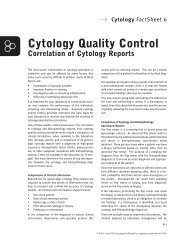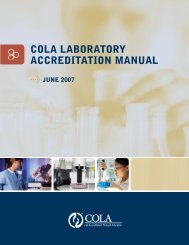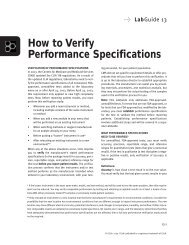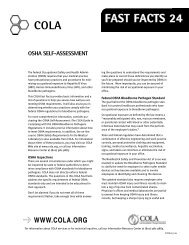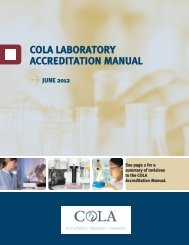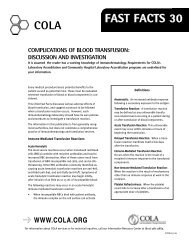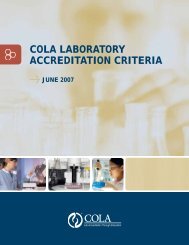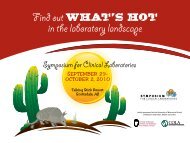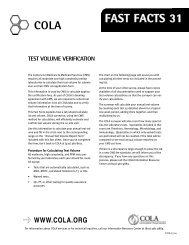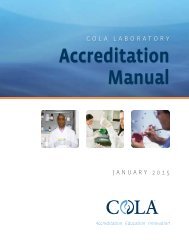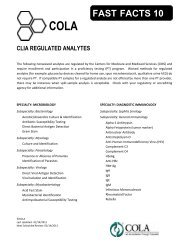#06-5558 Accrd Manual V7 - COLA
#06-5558 Accrd Manual V7 - COLA
#06-5558 Accrd Manual V7 - COLA
- No tags were found...
You also want an ePaper? Increase the reach of your titles
YUMPU automatically turns print PDFs into web optimized ePapers that Google loves.
HISTOPATHOLOGY>853. EElectronmicroscopy stains?In addition to written procedures the laboratory should have reference materials available to personnel suchas Ackerman’s Surgical Pathology, Armed Forces Institute of Pathology (AFIP) Laboratory Methods inHistotechnology, AFIP’s Advanced Laboratory Methods in Histology and Pathology and Pease’s HistologicalTechniques for Electron Microscopy which serve as the basis for these procedures.If non-pathologists perform gross tissue examinations, do the procedures define:854. EThe type of specimens to be examined,855. EThe extent and nature of the examination to be performed856. EThe nature and extent of pathologist oversight?Pathologists’ assistants have generally performed gross tissue processing on smaller tissue specimenswhich require limited dissections and have limited numbers of sections submitted for microscopic examination,i.e. excised scars and teeth requiring gross examination only; punch biopsies of skin, needle biopsiesof solid organs and excisional biopsies of benign skin lesions requiring very limited dissection before submissionof sections; or larger tissue specimens such as hernia sacs or gall bladders requiring limited dissectionprior to submission of sections.The laboratory should assess and verify qualifications, training, and competency of each individual performinggross tissue processing. The extent of supervision must be defined and may vary from indirect to consultativeto direct depending on the complexity level of the tissue specimen.857. EFor differential or special stains, is a control slide of known reactivity stained with each patient slide or groupof patient slides?The laboratory must demonstrate that each reagent performs within the specifications established by thelaboratory for each test procedure. For each staining run (group of slides stained together according to therequired procedural sequence), a quality control slide must be run with the patient specimens.858. EAre fluorescent and immunohistochemical stains checked for positive and negative reactivity with each patientslide or group of patient slides?The laboratory must demonstrate that each reagent performs within the specifications established by thelaboratory for each test procedure. For each staining run of patient samples, quality control slides must bechecked for positive and negative reactivity.Controls for Flow Cytometry. Staining controls for cell surface immunophenotyping by flow cytometry shouldconsist of either normal, cultured or abnormal cells known to be positive for selected standard antigens andmust verify the proper performance of reagents. Frozen or other preserved cells may be used. A negativereagent control must be run for each test cell preparation, and is to consist of monoclonal antibody(ies) ofthe same species and isotype or equivalent. Negative reagent controls will consist of: a) For indirect stains,an irrelevant primary antibody and the same secondary antibody(ies) conjugated with the same fluorochrome(s)used in all relevant test combinations; and b) For direct stains, an irrelevant antibody conjugatedto the same fluorchrome and at the same fluorchromes : protein ratio used in all relevant test combinations.. . . . . . . . . . . . . . . . . . . . . . . . . . . . . . . . . . . . . . . . . . . . . . . . . . . . . . . . . . . . . . . . . . . . . . . . . . . . . . . . . . . . . . . . . . . . . . . . . . . . . . . . . . . . . . . . . . . . . . . . .FOR MORE INFORMATION CONTACT <strong>COLA</strong> PHONE 800.981.9883 | FAX 410.381.8611 | ON-LINE www.cola.org101




